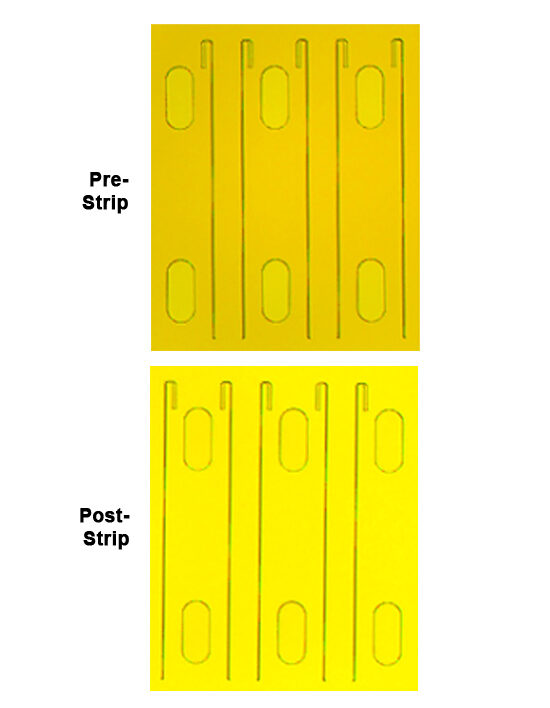Photoresist Strip Process
Using Solstice® Systems
Photoresist Strip (PR Strip) remains a common and necessary process step in semiconductor manufacturing. Two primary types of photoresist are used in the industry, and can differ greatly from one another in terms of removal. Positive photoresist (photodecomposing) tends to solvate readily in the presence of acetone and or NMP (1-methyl-2-pyrrolidone) with minimal to moderate mechanical agitation. Negative photoresist (either photopolymeric or photocrosslinking) can be much more resistant to chemical solvation and require very aggressive mechanical agitation for complete removal.
For readily solvated photoresist, a simple static wetbench may be adequate for efficient removal, though the inherently open-bath architecture of such systems imposes a real human safety consideration. For more crosslinked positive resists, or resists that have encountered a large number of process steps prior to strip step, a spray process is likely necessary for complete removal. In such a case, batch spray systems have a long track record of success. However, in a growing number of cases, due largely to feature scaling and diversified integration schemes, single wafer photoresist stripping offers the only option for complete and cost-effective resist strip. This is because single wafer employs direct wafer impingement flow for increased mechanical effect on the resist.
In the case of negative resist stripping, the need for single wafer capability becomes almost certain. This is because solvation alone is typically not sufficient for complete removal of bulk resist and residual organic material. In fact, it is not uncommon with negative photoresist that the mechanism of removal is more a matter of lift-off than solvation, meaning that the system must avoid redeposition of the lifted material and prevent adhesion to the chamber walls. Single wafer systems allow not only for direct impingement flow at a high flow rate (a flood flow condition that acts as a mechanically aggressive soak step) but also allow for simultaneous high-pressure solvent delivery to maximize mechanical agitation.
As to the issue of human safety in the manufacturing environment, most single wafer strip chambers feature a face-up architecture that inherently exposes the surrounding environment to solvent fumes, though a box or enclosure may be added so that the surrounding area of the chamber can be exhausted. This, of course, consumes tool space. Face-down chambers operate much like batch spray systems in that the chamber is always free of any solvent any time the chamber is opened.
The Solstice from ClassOne Technology offers the broadest process flexibility with flood-flow and high-pressure flow options to accommodate multiple integration schemes and photoresist types within a given fab while maintaining a wide process window. And its face-down architecture maximizes personnel safety and avoids the redeposition of lifted materials.
Typical Resist Strip Performance
- Supports all common semiconductor photoresist strip chemistries
- Positive and negative photoresists
- High-pressure spray capability when needed

Photoresist Strip (PR Strip) remains a common and necessary process step in semiconductor manufacturing. Two primary types of photoresist are used in the industry, and can differ greatly from one another in terms of removal. Positive photoresist (photodecomposing) tends to solvate readily in the presence of acetone and or NMP (1-methyl-2-pyrrolidone) with minimal to moderate mechanical agitation. Negative photoresist (either photopolymeric or photocrosslinking) can be much more resistant to chemical solvation and require very aggressive mechanical agitation for complete removal.
For readily solvated photoresist, a simple static wetbench may be adequate for efficient removal, though the inherently open-bath architecture of such systems imposes a real human safety consideration. For more crosslinked positive resists, or resists that have encountered a large number of process steps prior to strip step, a spray process is likely necessary for complete removal. In such a case, batch spray systems have a long track record of success. However, in a growing number of cases, due largely to feature scaling and diversified integration schemes, single wafer photoresist stripping offers the only option for complete and cost-effective resist strip. This is because single wafer employs direct wafer impingement flow for increased mechanical effect on the resist.
In the case of negative resist stripping, the need for single wafer capability becomes almost certain. This is because solvation alone is typically not sufficient for complete removal of bulk resist and residual organic material. In fact, it is not uncommon with negative photoresist that the mechanism of removal is more a matter of lift-off than solvation, meaning that the system must avoid redeposition of the lifted material and prevent adhesion to the chamber walls. Single wafer systems allow not only for direct impingement flow at a high flow rate (a flood flow condition that acts as a mechanically aggressive soak step) but also allow for simultaneous high-pressure solvent delivery to maximize mechanical agitation.
As to the issue of human safety in the manufacturing environment, most single wafer strip chambers feature a face-up architecture that inherently exposes the surrounding environment to solvent fumes, though a box or enclosure may be added so that the surrounding area of the chamber can be exhausted. This, of course, consumes tool space. Face-down chambers operate much like batch spray systems in that the chamber is always free of any solvent any time the chamber is opened.
The Solstice from ClassOne Technology offers the broadest process flexibility with flood-flow and high-pressure flow options to accommodate multiple integration schemes and photoresist types within a given fab while maintaining a wide process window. And its face-down architecture maximizes personnel safety and avoids the redeposition of lifted materials.
Typical Resist Strip Performance
- Supports all common semiconductor photoresist strip chemistries
- Positive and negative photoresists
- High-pressure spray capability when needed

